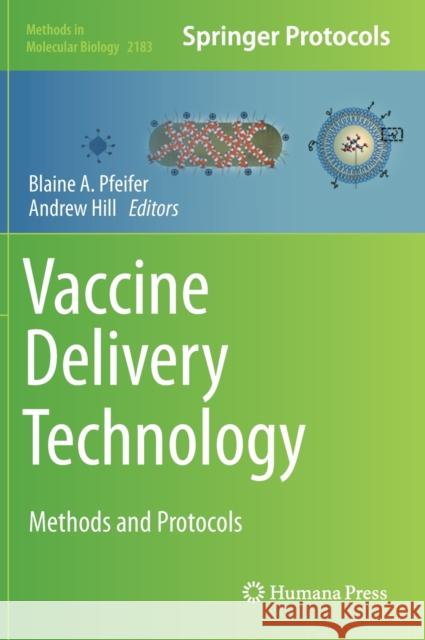Vaccine Delivery Technology: Methods and Protocols » książka



Vaccine Delivery Technology: Methods and Protocols
ISBN-13: 9781071607947 / Angielski / Twarda / 2020 / 590 str.
Vaccine Delivery Technology: Methods and Protocols
ISBN-13: 9781071607947 / Angielski / Twarda / 2020 / 590 str.
(netto: 768,56 VAT: 5%)
Najniższa cena z 30 dni: 771,08
ok. 22 dni roboczych.
Darmowa dostawa!
Preface…
Table of Contents…
Contributing Authors..
1. Vaccine Delivery and Immune Response Basics
Andrew Hill, Marie Beitelshees, and Blaine A. Pfeifer
2. Isolating Pathogen-Specific Human Monoclonal Antibodies (hmAbs) using Bacterial Whole Cells as Molecular Probes
Sara Siris, Camilla A. Gladstone, Yanping Guo, Christopher L. Pinder, Robin J. Shattock, Paul F. McKay, Paul R. Langford, and Fadil A. Bidmos
3. Use of Chlamydial Elementary Bodies as probes to Isolate Pathogen-Specific Human Monoclonal Antibodies
Christopher L. Pinder, Paul F. McKay, and Robin J. Shattock
4. Computational Antigen Discovery for Eukaryotic Pathogens using Vacceed
Stephen J. Goodswen, Paul J. Kennedy, and John T. Ellis
5. Antigen Discovery in Bacterial Pan-Proteomes
Daniel Yero, Oscar Conchillo-Solé, and Xavier Daura
6. Alphavirus-Based Antigen Preparation
Kenneth Lundstrom
7. Production of Chimeric Hepatitis B Virus Surface Antigens in Mammalian Cells
Mihaela-Olivia Dobrica, Catalin Lazar, and Norica Branza-Nichita
8. Bioreactor-Based Antigen Production Process using the Baculovirus Expression Vector System
Julie Harnischfeger, Lukas Käßer, Jan Zitzmann, Denise Salzig, and Peter Czermak
9. High-Throughput Process Development for the Chromatographic Purification of Viral Antigens
Shaleem I. Jacob, Spyridon Konstantinidis, and Daniel G. Bracewell
10. Production of Zika Virus Virus-Like Particles
Atichat Kuadkitkan Suwipa Ramphan, Suchin Worawichawong, Wannapa Sornjai, Nitwara Wikan, and Duncan R. Smith
11. Biosynthesis of Glycoconjugate Virus-Like Particles (VLPs)
Kathryn K. Oi, Tom A. Kloter, and Timothy G. Keys
12. Up- and Downstream Processes for Viral Nanoplaxes as Vaccines
Keven Lothert, Gregor Dekevic, Daniel Loewe, Denise Salzig, Peter Czermak, and Michael Wolff
13. Whole-Cell Vaccine Preparation: Options and Perspectives|
Punit Kumar, Sunita Verma, Kashyap Kumar Dubey, and Pratyoosh Shukla
14. O-Antigen Extraction, Purification, and Chemical Conjugation to a Carrier Protein
Francesca Micoli, Carlo Giannelli, and Roberto Di Benedetto
15. Oligosaccharide Antigen Conjugation to Carrier Proteins to Formulate Glycoconjugate Vaccines
Brittany R. Smith and Zhongwu Guo
16. Exploitation of Capsule Polymerases for the Enzymatic Synthesis of the Polysaccharide Antigens used in Glycoconjugate Vaccines
Christa Litschko, Insa Budde, Monika Berger, and Timm Fiebig
17. Attenuation Methods for Live Vaccines
Dipasree Hajra, Akshay Datey, and Dipshikha Chakravortty
18. Surface Modification of Adenovirus Vector to Improve Immunogenicity and Tropism
Yasmine Gabal and Joshua D. Ramsey
19. Production of Baculovirus and Stem Cells for Baculovirus-Mediated Gene Transfer into Human Mesenchymal Stem Cells
Friederike Eilts, Julie Harnischfeger, Daniel Loewe, Michael Wolff, Denise Salzig, and Peter Czermak
20. Lipofection-Based Delivery of DNA Vaccines
Monika Rak, Anna Góra-Sochacka, and Zbigniew Madeja
21. Flavivirus DNA Vaccine Design and Adjuvant Selection
Lei Li, Yoshikazu Honda-Okubo, and Nikolai Petrovsky
22. Vaccine Delivery with a Detoxified Bacterial Toxin
Diana Diaz-Arévalo, Yanping Chen, and Mingtao Zeng
23. Needle-Less or Non-Invasive Delivery Technology
Akshay Datey, Jagadeesh Gopalan, and Dipshikha Chakravortty
24. Lactic Acid Bacteria as Delivery Vehicle for Therapeutics Applications
Viviane Lima Batista, Tales Fernando da Silva, Luis Cláudio Lima de Jesus, Ana Paula Tapia-Costa, Mariana Martins Drumond, Vasco Azevedo, and Pamela Mancha-Agresti
25. A Hybrid Biological-Biomaterial Vector for Antigen Delivery
Ruiquan Qi, Andrew Hill, and Blaine A. Pfeifer
26. Liposomal Dual Delivery of Both Polysaccharide and Protein Antigens
Roozbeh Nayerhoda, Andrew Hill, and Blaine A. Pfeifer
27. Thin-Film Freeze-Drying is a Viable Method to Convert Vaccines Containing Aluminum Salts from Liquid to Dry Powder
Riyad F. Alzhrani, Haiyue Xu, Chaeho Moon, Laura J. Suggs, Robert O. Williams III, and Zhengrong Cui
28. The Application of Cryogenic Transmission Electron Microscopy for Evaluation of Vaccine Delivery Carriers
Hui Qian, Yimei Jia, and Michael J. McCluskie
29. Methods to Evaluate Immune Cell Recruitment and the Cellular Uptake and Distribution of Antigen following Intramuscular Administration of Vaccine to Mice
Gerard Agbayani, Felicity C. Stark, Bassel Akache, and Michael J. McCluskie
30. The Quantification of Antigen-Specific T Cells by IFN-γ ELISpot
Bassel Akache and Michael J. McCluskie
31. The Measurement of Antigen-Specific IgG Titers by Direct ELISA
Bassel Akache, Felicity C. Stark, and Michael J. McCluskie
32. Method to Evaluate In Vivo CD8+ T Cell Cytotoxicity in a Murine Model
Felicity C. Stark, Renu Dudani, Gerard Agbayani, and Michael J. McCluskie
33. Testing Anti-Pneumococcal Antibody Function using Bacteria and Primary Neutrophils
Manmeet Bhalla, Shaunna Simmons, Essi Y.I. Tchalla, and Elsa N. Bou Ghanem
34. Viral Infectivity Qunatification and Neutralization Assays using Laser Force Cytology
Colin G. Hebert, Keya L. Rodrigues, Nicole DiNardo, and Anna-Barbara Hachmann
1997-2025 DolnySlask.com Agencja Internetowa
KrainaKsiazek.PL - Księgarnia Internetowa









